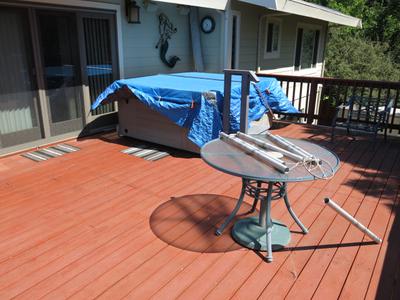What I Learned About Composite Decks
by Les
(San Rafael, CA)

Before
In no particular order:
Composite wants straight joists; it is not as forgiving as wood. Irregularities will show. Shimming may still be necessary. 5ft. levels were used to check the plane.
Apply butyl tape (aka: “bitchathane”) to tops of all joists. Paint all bare wood.
Get yourself an impact driver for removal of old screws.
16” joist centers are acceptable, but 12” is preferred. Blocking perpendicular to the joists is recommended every 4ft. - if for no other reason than to have something to brace against when pushing with clamps
Joists must be solid wood, repair rot in many ways: liquid hardener, “Dutchman,” replace with new, or sister.
TimberTeck specifications call for double joist or double blocking (sistering) wherever a butt joint is because of fastener positioning requirements. To do over again, I’d reconsider screwing in “L” brackets underneath or the Fibron clip system.
Screws pull the planks down firmly. If screwing down through the plank (e.g. Cortex), pre-drilling will help with questionable wood (i.e. rot). All ends must be pre-drilled to avoid chance of splitting.
If Cortex screw doesn’t go deep enough, then plug bottom must be shaved down to prevent bottoming out. Plugs are more noticeable not because of poor color match, but rather when they are not flush. To remove a plug, center punch, use a slightly smaller diameter drill at super slow speed and it’ll lift right out.
Assume composite planks as not reusable if screwing them in through the face. The composite encloses slightly around the head, preventing it from rising back up. Force lifting will crack the plank across the screw holes. With hidden fasteners, there is a better chance of reusing the plank.
The majority of this job was using CONCEALoc Hidden Fastener.
The CONCEALoc Hidden Fastener screw heads were non-forgiving, i.e. soft metal. You get only one chance or the head strips. The clips’ tabs might need aligning up or down to fit plank’s groove.
Hidden fasteners are not as simple to use as the videos portray. Bar and pipe clamps were used to pull/push the plank into the proper gap. And then a good whack with a heavy hammer onto scrap wood to set the plank.
The crew noted that the TimberTech was cooler to handle than Trex on hot days. We used TimberTeck Pro, Reserve Collection “Antique Leather.” Cortex offers a matching plug. Antique Leather has varying colors running through it, so take your time matching the plugs. Again, the most important thing to make the plugs “disappear” is making them flush (use a plastic head hammer).
Butt gaps vary with temperature. At over 90°F. the gap utilized was a tight 1/16”. We actually notice the expansion and contraction as the temperature changes.
Carry composite planks over 16ft. vertical on edge.


































